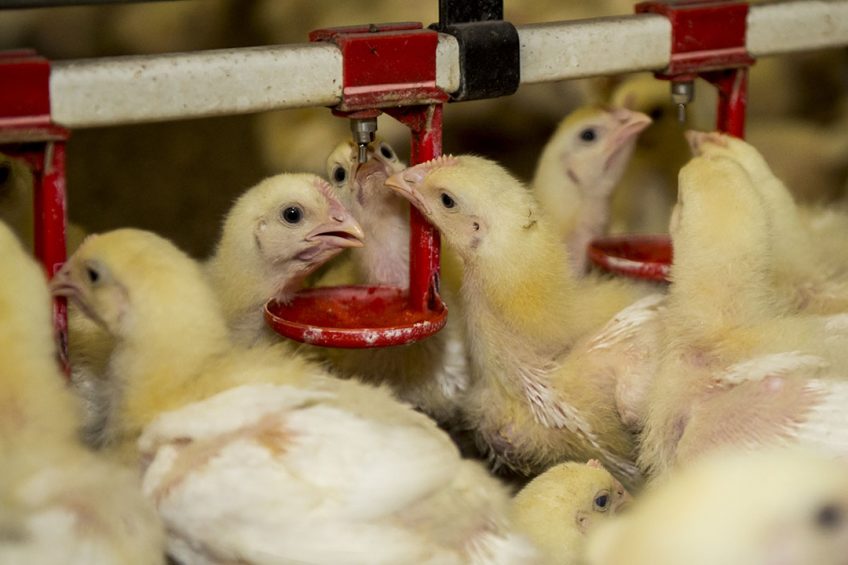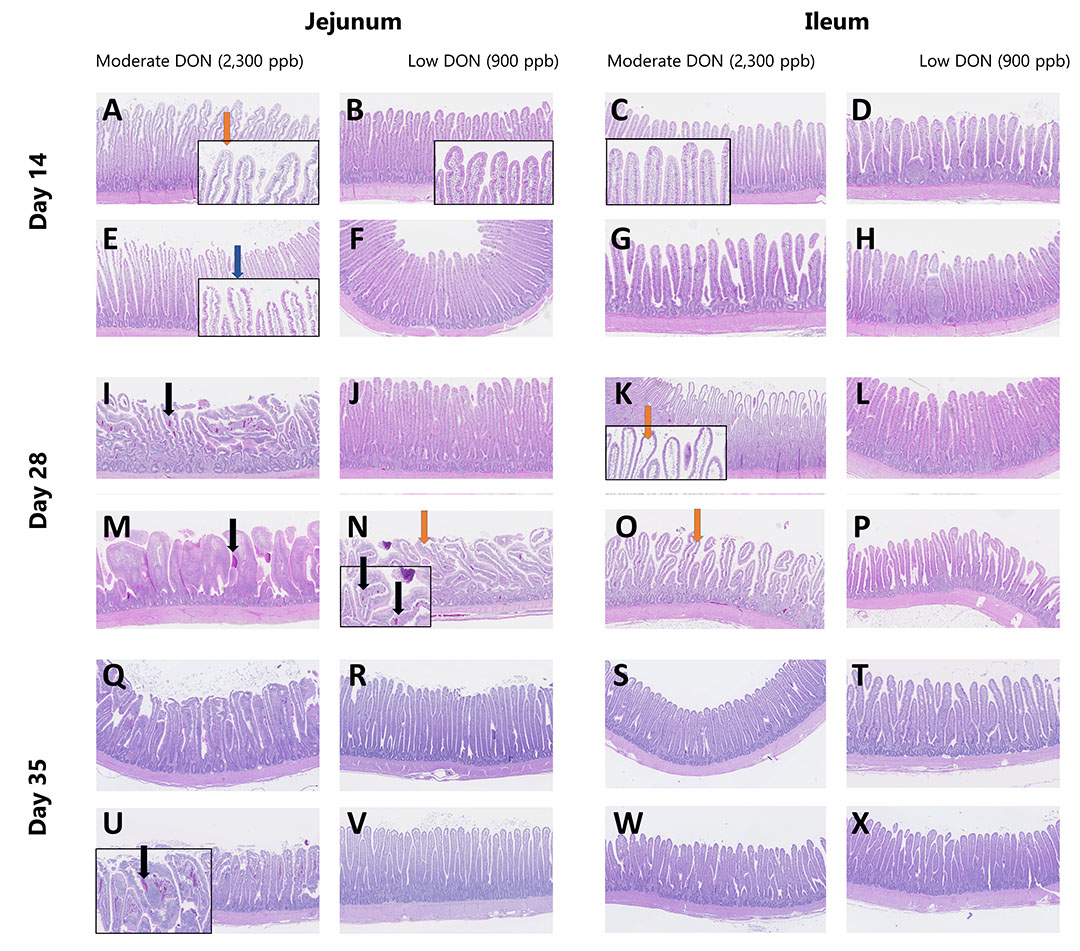Impact on broilers fed anticoccidial-free diets with DON

Reducing anticoccidials in poultry feed may affect the impact of mycotoxins on broilers.This study evaluated the effect of different levels of DON on the performance and intestinal integrity of broilers.
The ongoing discussion about reducing antibiotics and their potential impact on the use of anticoccidials, particularly those in the class of ionophores, poses a concern for the broiler industry.
This class of anticoccidials fits the classical definition of an antibiotic because they have some antibacterial activity. This means that the importance of mycotoxins in the poultry industry may increase in a situation where ionophore anticoccidials are banned from feed. What’s more, the subclinical and indirect effects of mycotoxins are often underestimated because no typical mycotoxicosis symptoms are observed.
In general, mycotoxins may be involved in numerous subclinical symptoms and will potentiate the negative effect of diseases or simply lead to impaired performance.
The research design
Recently, Schothorst Feed Research evaluated the effect of low (900 ppb) and moderate (2300 ppb) levels of deoxynivalenol (DON) on the performance and intestinal integrity of broilers. To mimic on-farm conditions, it’s important to expose broilers to feed naturally contaminated with mycotoxins. Furthermore, realistic contamination levels need to be considered when applying naturally contaminated diets. The maximum acceptable level of DON in cereals and cereal products used for feed production is 8000 ppb while, for maize by-product feed materials, it is 12,000 ppb (EC 576/2006). Considering that northwestern European broiler diets contain approximately 30% wheat, it will be difficult to get to 4000 ppb in the final diet. Based on this, we can expect only low to moderate levels of DON in broiler diets, e.g., 1000 ppb to 3000 ppb. The type of feedstuff added to the diet also interferes with intestinal health and broiler performance.
For this study, broilers were exposed during the starter and grower phase to 2 different levels of DON (900 ppb or 2300 ppb). In the finisher period, they received a diet with a negligible level of DON (57.3 ppb) to evaluate carryover effects. As a positive control, activated charcoal (AC) was tested at each DON level. Furthermore, feed was not supplemented with anticoccidials or NSP enzymes, with the aim of evaluating animal performance and intestinal integrity. The mycotoxins’ contents of the experimental diets are given in Table 1.
Body weight
The average body weight of the birds at the start of the trial was 42.7 g for all treatments. The lowest body weight (BW) at D14 and D28 was observed in broilers fed the moderate DON (MD), regardless of the dietary supplementation with activated charcoal. During the starter (D0–14; Table 2) and grower (D14–28) periods, there were no interactions between DON level and activated charcoal. The lowest body weight gain (BWG) and highest feed conversion ratio (FCR) at D14 and D28 was observed when birds were fed the MD diet, regardless of the dietary supplementation with activated charcoal. Considering the complete feeding period (D0–35; Table 2), no interactions between DON and activated charcoal were observed, but broiler chickens fed the MD diet during the starter and grower phase had a significantly lower BWG and a higher FCR, even if they were fed a marginally contaminated diet in the finisher period.
Broiler performance
DON can impair the performance of broiler chickens, even at moderate levels (2300 ppb). Also, this negative effect is not mitigated when the chickens are subsequently fed a diet with negligible levels (57.3 ppb) of DON for 7 days. In the current study, instead of challenging the birds with Eimeria spp. oocysts, anticoccidials were excluded from the diet formulation. Coccidiosis not only leads to clinical signs but can also result in poor performance.
Mycotoxin levels
Although the diets were contaminated with a variety of mycotoxins, the negative impact observed in the current study was basically caused by DON. Besides DON, the other mycotoxins current in the diets were deoxynivalenol-3-glucoside (DON-3-G), enniatins B and B1 (ENNB+B1), zearalenone (ZEN), ochratoxin A (OTA), alternariol (AOH), and alternariol methyl ether (AME). The levels of ZEN, OTA, AOH, and AME were negligible. The DON-3-G is a metabolite from DON, but without high toxicity to poultry. Therefore, the observed dietary levels between 10.7 ppb and 1670 ppb in the current study should not be a reason for concern.
The intestinal integrity of broilers
Intestinal morphometric changes in the first 14 days of exposure were negligible and limited to an increase in the VH:CD ratio in the ileum of broilers fed the MD diet, regardless of the presence of activated charcoal, indicating that cell proliferation decreased in broilers fed the MD diet without resulting in immediate villus shortening. This was expected, since DON decreases cell proliferation and the crypt is responsible for cell renewing and maintenance of villus length.
After 28 days – lower villus height
After 28 days, however, broilers fed the MD diet had a significantly lower villus height and VH:CD ratio than those fed the LD diet. This leads us to infer that birds fed the MD diet were probably trying to maintain villus height by a compensatory increase in the proliferation in the crypt, which required extra energy. Besides this, shortened villi and deeper crypts will result in suboptimal nutrient absorption and impaired animal performance. This matches the observed decreased BWG and increased FCR at D28. The ileum had a higher VH:CD ratio due to an increase in crypt depth, showing that in this intestinal section, cell proliferation was increased to keep villus height similar to the expected (LD diet) levels. Such a compensatory mechanism, which costs energy, will result in suboptimal performance.
Day 35
At D35, no differences were observed, because the finisher diet had negligible levels of DON and intestinal cell turnover takes around 48 h to 96 h. At D14, lesion scores were significantly increased when birds were fed a MD diet supplemented with activated charcoal, whereas at D28, the highest lesion scores were observed in broiler chickens receiving a non-supplemented MD died. No dietary effects were observed at D35.

Figure 1 illustrates examples of jejunum and ileum sections from broilers fed MD and LD diets either supplemented or not with activated charcoal. Based on the morphometric analysis and lesion scores in the jejunum and ileum, it can be concluded that the jejunum was the intestinal section that was more sensitive to DON than the ileum.
Moreover, broiler chickens fed a diet containing moderate levels of DON (2300 ppb) will perform inefficiently. The influence of mycotoxins on poultry performance should be assessed not only on its toxicity per se, but also considering animal age, dietary composition, and the presence of other types of additives, such as anticoccidials.











